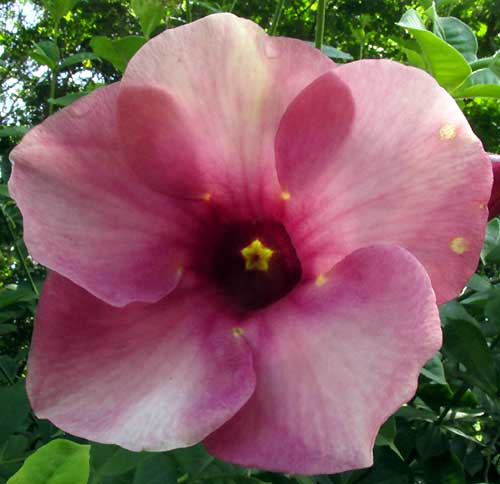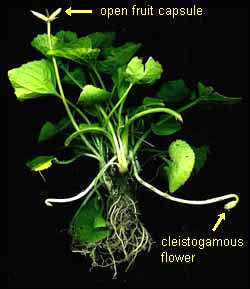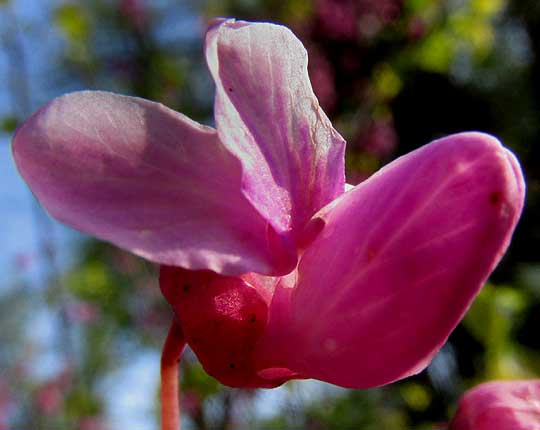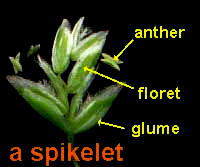FLOWER TERMS
scroll down with scrollbar at right
 ACTINOMORPHIC FLOWER
ACTINOMORPHIC FLOWERament: a catkin, which is a scaly-bracted, usually drooping spike or spike-like raceme with unisexual flowers; typical of willows and poplars
anther: the pollen-producing part of the stamen, usually borne atop the filament
anthesis: the time of expansion of a flower
apetalous: having no petals
apocarpous: carpels separate, not united
bract: a much-reduced leaf, especially the small or scale-like leaves in a flower cluster, or associated with flowers
bractlet: bract borne on a secondary axis, as on a pedicel or the petiole
calyx: the outer circle of floral envelopes, comprised of sepals
calyx tube: the tube of a calyx in which the sepals are grown together
campanulate: bell-shaped
carpel: one unit of a compound pistil or ovary; a simple pistil has one carpel
catkin: a scaly-bracted, usually drooping spike or spike-like raceme with unisexual flowers; typical of willows and poplars
 CLEISTOGAMOUS FLOWER
CLEISTOGAMOUS FLOWERcleistogamous flowers: small, closed, self-fertilized flowers, as in some violets; they mostly grow on or under the ground
composite: a term referring to an organ or structure that looks like one large thing, but actually is composed of several distinct parts, as among blossoms of the Composite Family
corolla: the inner circle or whorl of floral envelopes; if the parts are separate, they are petals, but if the parts are united they are corolla lobes
corymb: a short, broad, more or less flat-topped, indeterminate flower cluster in which the outer flowers open first
cyme: a broad, more or less flat-topped, determinate flower cluster in which the central flowers open first
diadelphous: describing a flower's cluster of stamens in which the stamens are held in two bundles or clusters, as in many legumes in which there are nine stamens in one bundle and one stamen in the second (as opposed to monadelphous)
dioecious: describing a plant in which the staminate (male) flowers and the pistillate (female) flowers occur on separate plants, so you can speak of the "male plant" and the "female plant"
disk-flowers: tubular flowers in the center heads of most Composite-Family members, as distinguished from the ray-flowers
filament: the stalk of the anther
florets: individual flowers of composites and grasses
gamopetalous: corolla with the petals united, at least at their base, so that the corolla is removable as a single structure
glume: a small bract, especially one of the two empty bracts at the base of a grass spikelet
gynoecium: the female part of a flower
head: a compact mass of flowers at the top of a stem
 HYPANTHIUM ON WILD ROSE
HYPANTHIUM ON WILD ROSEhypanthium: the cup-like receptacle on which are borne calyx, corolla and stamens; sometimes called the "calyx tube"
hypogynous: borne below the ovary; said of the stamens or petals
inferior ovary: an ovary developed below the calyx's sepals
inflorescence: the "flower cluster," or "mode of flower bearing"
involucre: one or more whorls of bracts located close beneath a flower or flower-cluster
irregular flower: non-symmetrical flowers; flowers in which some parts differ from other parts in the same series -- so some stamens may be long and some short, or some sepals may be larger than others
keeled: in papilionaceous flowers, the two front united petals, which unite to form a ridge like the bottom of a boat
labellum: the lip, as the lip of an orchid flower
lemma: in grasses, the lower of the two bracts immediately inclosing the flower, the upper one being the palea
monadelphous: stamens united in one group by their filaments (as opposed to diadelphous)
monoecious: staminate (male) and pistillate (female) flowers on the same plant, as in corn (as opposed to dioecious, in which unisexual flowers occur on the separate plants)
naked flower: having no floral envelope (no calyx or corolla)
ovary: the ovule-bearing part of a pistil
ovule: the body which, after fertilization, comes the seed
palea: in grass flowers, the upper of the two inclosing bracts, the lower one being the lemma
panicle: an indeterminate, branching raceme; a flower-cluster in which the branches are racemose and the flowers are pedicellate
 PAPILIONACEOUS FLOWER
PAPILIONACEOUS FLOWERpapilionaceous corolla: butterfly-like; a pea-like flower, with a standard, wings and keel
pappus: on composite flowers, special appendages borne on the ovary and persisting in the fruit, and appearing in a variety of shapes, as plumose (feather-like), bristles, scales, crowns, etc.
peduncle: stem of a flower-cluster, or of a solitary flower when that flower is the only member of an inflorescence
perianth: the calyx and corolla considered together
perigynous: borne around the ovary and not beneath it
petal: one unit of the corolla, usually colored and more or less showy
pistil: the female part of the flower, composed of ovary, style and stigma
pistillate: said of unisexual female flowers -- having pistils but no functional stamens
placentation: the arrangement of ovules within the ovary
pollen: spores or grains borne by the anther containing the male sex germ
pollinium: a stuck-together mass of pollen, as in orchids and milkweeds
polygamous: bearing unisexual and hermaphrodite flowers on the same plant
raceme: a simple, elongated, indeterminate inflorescence with pedicelled flowers
ray: outer florets of some composites, bearing flat, corolla-like appendages; also the branches of an umbel or umbel-like cluster
receptacle: the more or less expanded apex of a floral axis which bears the floral parts, as the collection of bracts below the disk and ray flowers of a sunflower
regular flower: a symmetrical flower in which each part of a series is like all other parts -- so all stamens would be alike, all sepals the same length, etc.
salverform: having a slender tube and an abruptly expanded, flat limb, as with the phlox flower
sepal: one of the parts of a calyx
sessile: having no stalk
spike: an unbrached, elongated, simple, indeterminate inflorescence with sessile flowers
 GRASS SPIKELET
GRASS SPIKELETspikelet: the floral unit, or ultimate cluster, of a grass inflorescence comprised of flowers and their subtending bracts
stamen: the male part of the flower typically composed of the sac-like, pollen-producing anther atop the stem-like filament
standard: the upper and broad petal of a papilionaceous flower
stigma: the part of the pistil that receives the pollen
style: the more or less elongated part of the pistil between the ovary and the stigma
superior ovary: ovary that is free from the calyx or perianth
tepal: segment of a perianth not clearly differentiated into typical corolla and calyx, as among the tulip or onion
thyrse: compact, more or less compound panicle, as among most lilacs
umbel: an indeterminate, often flat-topped inflorescence whose pedicels and peduncles arise from a common point
unisexual: of one sex; having stamens only, or pistils only
zygomorphic: said of asymmetrical corollas -- corollas divisible into equal halves in one plane only; as opposed to "actinomorphic"